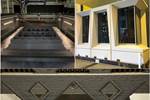Composite current collectors to enable EV battery efficiency
Researchers at ORNL have developed a metal-free current collector using carbon fiber and nanotubes to further lightweight lithium-ion batteries and increase energy density, improving EV driving range.
Jaswinder Sharma makes battery coin cells with a lightweight current collector made of thin layers of aligned carbon fibers in a polymer with carbon nanotubes (CNTs). Photo Credit: Genevieve Martin/ORNL, U.S. Dept. of Energy
Electric vehicles (EV) have the potential to drive longer distances if their lithium-ion batteries deliver more energy in a lighter package. A prime weight-loss candidate is the current collector, a component that often adds 10% to the weight of a battery cell without contributing energy. With this in mind, researchers at the Oak Ridge National Laboratory’s (ORNL, Oak Ridge, Tenn., U.S.) Department of Energy have developed a lighter, metal-free current collector made of a polymer-based composite with carbon fibers. The aligned fibers work together with a thin film of carbon nanotubes (CNTs) to enhance directional and uniform current flow.
According to the research paper on this development, “A lightweight and metal-free current collector for battery anode applications,” much work has been done over the years to improve anode and cathode performance, but little has been done regarding current collectors — which “act as a substrate for the deposition of electrode layers and a medium for electron transfer between electrodes and external circuits” — in terms of their weight (10 wt% of the total cell weight) or performance. Conventional current collectors include aluminum foil for cathode and copper foil for anode.
Alternatively, development of current collectors made of assembled metal or carbon nanostructures such as metal, graphene, CNT or carbon fiber foams, and other similar structures, have shown potential, particularly carbon fiber and CNTs. The former is characterized by high thermal and electrical conductivity and good mechanical properties, necessary to this application, while the latter, while unable to stand on their own, contribute to high electronic conductivity.
Lab tests conducted at medium-fast battery charging rates showed the novel composite current collector performed as well as or better than the standard copper foil. Importantly, ORNL’s carbon polymer material is less prone to corrosion and can stretch more easily for roll-to-roll manufacturing of electrodes.
“We are reducing 80% to 90% of the weight of the current collector,” ORNL’s Jaswinder Sharma and a researcher in this project, notes. “This will help a lot in increasing the energy density of battery packs.”
For more information, read the complete paper here.
Related Content
-
Troubleshooting thermal design of composite battery enclosures
Materials, electrical insulation and certification are all important factors to consider when optimizing electric battery performance against potential thermal runaway.
-
Protecting EV motors more efficiently
Motors for electric vehicles are expected to benefit from Trelleborg’s thermoplastic composite rotor sleeve design, which advances materials and processes to produce a lightweight, energy-efficient component.
-
Price, performance, protection: EV battery enclosures, Part 1
Composite technologies are growing in use as suppliers continue efforts to meet more demanding requirements for EV battery enclosures.

















